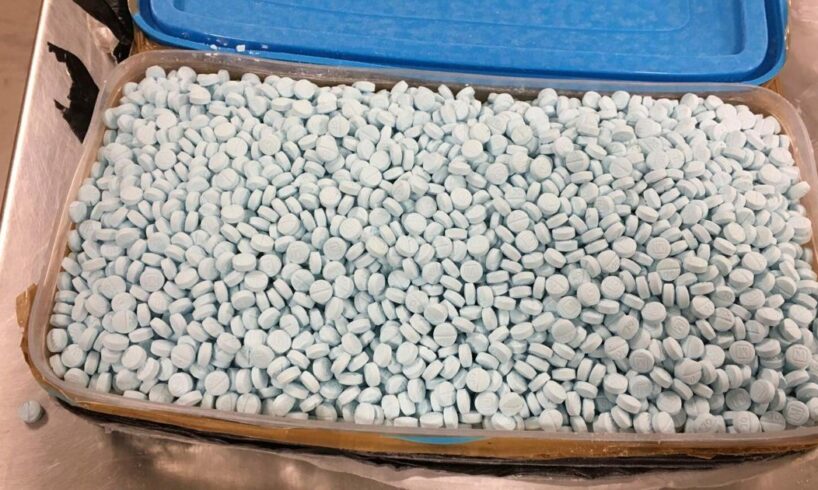
Law enforcement investigations continue to target cartel-driven drug trafficking networks nationwide as Mexican cartels maintain operational control of the southern border, and transport dangerous narcotics and synthetic opioids to major U.S. cities.
Last year, law enforcement officials announced some of the biggest drug busts in their region’s history, from California to Arizona to Texas and other states. And Colorado was no exception.
Last month, a multi-agency effort, led by the DEA Denver Division, announced the result of an eighth month-long investigation into a drug trafficking operation that funneled heroin, methamphetamine, cocaine and counterfeit pills laced with fentanyl into the Denver area.
The investigation wasn’t about “the amount of drugs seized or number of people arrested,” DEA Denver Acting Special Agent in Charge David Olesky said, although it was historic. It was about “an alarming trend in counterfeit prescription pills laced with fentanyl flooding our streets, as well as the continuing nexus between drug trafficking and violent crime impacting our communities.”
Investigators confiscated 110,000 counterfeit prescription pills laced with fentanyl. Two of every five, on average, had enough fentanyl to be potentially lethal, Olesky said. In total, the pills equated to an estimated 40,000 lethal doses.
Two milligrams of fentanyl, the approximate weight of a mosquito, is lethal. A teaspoon holds about 5,000 milligrams, enough to kill 2,500 people. One pound of fentanyl, or 453,592 milligrams, could kill 226,796 people.
Investigators also confiscated 11.5 kilograms of cocaine, 6 kilograms of methamphetamine, and 8.5 pounds of heroin.
The DEA worked with federal, state, and local law enforcement partners in the 18th Judicial District where prosecution is overseen by District Attorney John Kellner. Partners included the Rocky Mountain High Intensity Drug Trafficking Area, the sheriffs’ offices of Arapahoe and Douglas counties, the police departments of Denver, Arvada, and Commerce City, along with Homeland Security Investigations. The district serves 1.3 million people who live in Denver suburbs and in rural communities.
“This poison is coming over from our southern border unchecked,” Kellner said when announcing the drug bust. “It will not stop coming over the border from Mexico into our communities until the federal government takes that porous border seriously.”
They are “people who peddle deadly substances. And where we find the illegal drug trade, we usually find illegal weapons,” he said.
Investigators confiscated 28 firearms, of which six were stolen, three hand grenades, multiple high-capacity magazines including one 200 round “drum” magazine, armor piercing ammunition, body armor with rifle rated ballistic armor plates, and $450,000 in U.S. currency.
“This organization was preparing for a battle,” Olesky said. “One which played out on multiple occasions throughout the investigation.”
Suspects reportedly fired their weapons out of their car windows as well as in their backyard for fun, investigators found.
Nineteen people were indicted, the DA’s office said, with another two later arrested on similar charges. Charges range from racketeering and conspiracy to drug distribution and money laundering, with the top counts being Class 2 felonies.
The drug ring was allegedly overseen by 30-year-old Saul Ramon Rivera-Beltran of Thornton, according to the DA’s office. Rivera-Beltran laundered the profits out of the U.S. using guns and violence, the office said, coordinating the drug deals and shipments from Mexico and managing a distribution network that crossed the southern border spanning at least 1,400 miles from the Sinaloa Cartel’s headquarters in Mexico, to eventually reach Kellner’s district.
Fentanyl is far less expensive to produce and more profitable to sell than other narcotics. It’s also relatively easy to deliver to Mexican ports primarily controlled by the Sinaloa Cartel, where product in its pure form arrives from China.
Once in Mexico, cartel operatives turn the drug into pill form. It’s often dyed blue and stamped to look like the prescription pill oxycodone or OxyContin. It’s referred to as “Mexican Oxy” or “M30s,” because the sides of the pill are stamped “30” and “M.”
In Mexican cities, the pills can be made for roughly 4 cents each. They’re sold in the Denver area wholesale for $3 a pill or retail for $10 to $20, investigators say.
In 2020, drug overdose deaths were up 34% in Colorado. In Denver, the Denver Department of Health reported “the percentage change in drug-related deaths for the six months of January-June from 2019 to 2020 was 83%, with fentanyl-related overdose deaths experiencing a 354% increase in those same timeframes.”
Nationwide, from April 2020 to April 2021, the CDC reported 100,306 drug-related overdoses nationwide.
“That’s a record number of drug overdoses in the history of tracking these types of statistics,” Olesky said. “And the main driving force behind this overdose epidemic is the synthetic opioid drug fentanyl.”
Fentanyl is now the leading cause of death among adults between the ages of 18 and 45, a nonprofit, Families Against Fentanyl, reports. The group has called on the Biden administration to label fentanyl as a weapon of mass destruction, which the administration hasn’t yet done.
Federal statute partially defines WMDs as “any weapon that is designed or intended to cause death or serious bodily injury through the release, dissemination, or impact of toxin or poisonous chemicals, or their precursors.”
Republican governors have called on the Biden administration to close the border, arguing his policies have only emboldened the cartels that are profiting billions of dollars off of the death of Americans. Instead, the White House maintains its immigration policies are humane and issued recommendations to Congress to reduce fentanyl’s supply and availability.
This article was originally posted on Major drug bust in Denver shows Mexican cartels’ reach